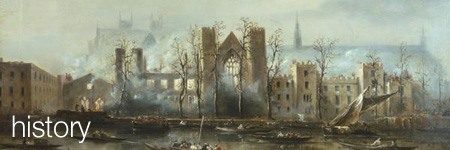
Strand
Westminster (WC2) The name of the Strand is clearly of Saxon origin. It is recorded that upon the Strand Earl Godwin and his son Harold drew up their land forces in the insurrection which they headed against Edward the Confessor in A.D. 1052.
The Strand has witnessed in its day some strange and curious sights. For instance, we read that Queen Elizabeth I, when she rode into the City, sat on a pillion behind her Lord Chancellor, wagons and the newly-invented carriages being in disfavour with her Majesty.
Among the numerous pageants which the thoroughfare of the Strand has witnessed may be mentioned the procession of Queen Elizabeth I in state to St. Paul's to return thanks for the victories over the Spanish Armada.
Queen Anne passed this way in state to St. Paul's on several occasions, to commemorate victories over France and Spain.
In a similar manner were commemorated the victories of Blenheim, Ramillies, and other important triumphs, the funeral procession of Lord Nelson in 1806, and that of the Duke of Wellington in 1852, etc., etc. (Reference: Thornbury's Old and New London, vol. III, p. 61)
"Up to the year 1353," says Pennant, "the Strand was an open highway, with here and there a great man's house, with gardens to the waterside. In that year it was so impassable, that Edward III, by an ordinance, directed a tax to be raised upon wool, leather, wine, and all goods carried to the staple at Westminster from Temple Bar to Westminster Abbey, for the repair of the road; and that all owners of houses adjacent to the highway should repair as much as lay before their doors."
It was not paved until 1532. It is rich in memories of the past. A whole nest of narrow streets, alleys, and lanes were swept away in the building of the Law Courts, some of them with historic memories like Lower Serle Place, which, as Shire Lane, saw some of the famous gatherings of the Kit-Cat Club, and where Addison wrote many of his delightful Tatler papers. The Kit-Cat Club derived its name from Christopher Cat, who kept the "Fountain" Tavern. He was celebrated for the excellence of his mutton-pies, and in his house the club first met. (Reference: Smith's Streets of London)
St. Clement Danes Church, which stands isolated in the middle of the roadway, has a very ancient history. It is believed that the bones of King Harold and of many Danish invaders of this country lie beneath it. Its bells were famous in Shakespeare's time, as are the present bells, which were cast in 1693. Dr. Johnson attended this church, and the pew he occupied can be seen today.